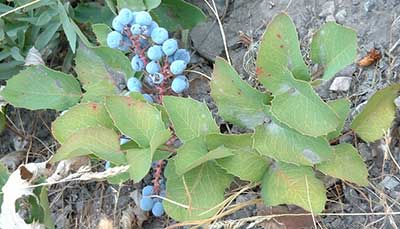Oregon Grape (Creeping Mahonia)
- Scientific Name: Berberis repens
- Garden: Beneficial Insects and Compost Garden, Natives Garden
- Plant Type: Shrub
- Evergreen/Deciduous: Evergreen
- Sun/Shade Exposure: Part Shade
- Moisture Requirements: Moist, Well-Drained
Plant Information
Mahonia repens generally grows to only about a foot in height, with a spread to three feet. The spines on the more rounded leaves are papery, so not too dangerous to place near a path. A species from east of the Cascades, low Oregon grape will grow happily in full sun to full shade; it is the most successful for perpetually dry shade and once established is drought tolerant even in sunny conditions. Full sun and winter cold give the leaves a bronze cast. A great plant for cover and food for ground-feeding birds. Mahonia repens is considered a noxious weed in other parts of the country but is fully garden-worthy here in its native range. Native Range: One or more of the four native species of Mahonia can be found in almost every county in Oregon; common along the entire west coast and eastward toward the Rockies. Characteristics: Evergreen woody-stemmed shrubs with distinct holly-like leaves. Bronze-colored new growth in spring, with mounds of small, bright yellow fragrant flowers in spring, followed by clusters of round, dusky blue (edible, though often sour) fruit. Foliage often takes on a striking red to purplish cast in fall-winter. Culture: Grows best in partial sun - though some species can thrive in full shade to full sun - rich acidic soil, and to moist to dry conditions. Avoid planting Oregon grape in soil that is compacted, wet, or too alkaline; plants should also be protected from winter winds. Pests/Diseases: Leaves can become chlorotic in soil that is too alkaline and can suffer leaf-burn in winter winds. Occasionally some leaf spot in too-wet conditions, but virtually pest and disease free.
Data Source
www.portlandnursery.comPlant Photos



